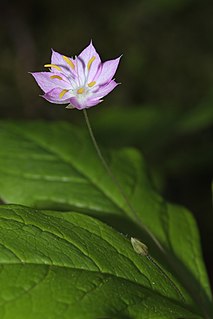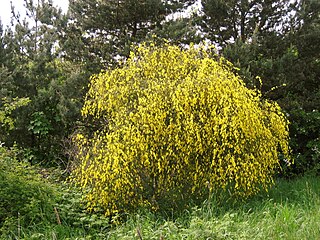 W
WA cushion plant is a compact, low-growing, mat-forming plant that is found in alpine, subalpine, arctic, or subarctic environments around the world. The term "cushion" is usually applied to woody plants that grow as spreading mats, are limited in height above the ground, have relatively large and deep tap roots, and have life histories adapted to slow growth in a nutrient-poor environment with delayed reproductivity and reproductive cycle adaptations. The plant form is an example of parallel or convergent evolution with species from many different plant families on different continents converging on the same evolutionary adaptations to endure the harsh environmental conditions.
 W
WAn epiphyte is an organism that grows on the surface of a plant and derives its moisture and nutrients from the air, rain, water or from debris accumulating around it. Epiphytes take part in nutrient cycles and add to both the diversity and biomass of the ecosystem in which they occur, like any other organism. They are an important source of food for many species. Typically, the older parts of a plant will have more epiphytes growing on them. Epiphytes differ from parasites in that they grow on other plants for physical support and do not necessarily affect the host negatively. An organism that grows on another organism that is not a plant may be called an epibiont. Epiphytes are usually found in the temperate zone or in the tropics. Epiphyte species make good houseplants due to their minimal water and soil requirements. Epiphytes provide a rich and diverse habitat for other organisms including animals, fungi, bacteria, and myxomycetes.
 W
WA forb or phorb is a herbaceous flowering plant that is not a graminoid. The term is used in biology and in vegetation ecology, especially in relation to grasslands and understory.
 W
WIn botany and ecology, graminoid refers to a herbaceous plant with a grass-like morphology, i.e. elongated culms with long, blade-like leaves. They are contrasted to forbs, herbaceous plants without grass-like features.
 W
WHerbaceous plants in botany, frequently shortened to herbs, are vascular plants that have no persistent woody stems above ground. Herb has other meanings in cooking, medicine, and other fields. Herbaceous plants are those plants that do not have woody stems. This includes many perennials, and nearly all annuals and biennials. Herbaceous plants include graminoids, forbs, and ferns. Forbs are generally defined as herbaceous broad leafed plants, while graminoids are plants with grass-like appearance including the true grasses, sedges, and rushes.
 W
WA liana is a long-stemmed, woody vine that is rooted in the soil at ground level and uses trees, as well as other means of vertical support, to climb up to the canopy in search of direct sunlight. Lianas are characteristic of tropical moist deciduous forests, but may be found in temperate rainforests and temperate deciduous forests. There are also temperate lianas, for example the members of the Clematis or Vitis genera. Lianas can form bridges amidst the forest canopy, providing arboreal animals with paths across the forest. These bridges can protect weaker trees from strong winds. Lianas compete with forest trees for sunlight, water and nutrients from the soil. Forests without lianas grow 150% more fruit; trees with lianas have twice the probability of dying.
 W
WMallee is the growth habit of certain eucalypt species that grow with multiple stems springing from an underground lignotuber, usually to a height of no more than 10 m (33 ft).
 W
WPleuston are the organisms that live in the thin surface layer existing at the air-water interface of a body of water as their habitat. Examples include some cyanobacteria, some gastropods, the ferns Azolla and Salvinia and the seed plants Lemna, Wolffia, Pistia, Eichhornia crassipes and Hydrocharis. Some fungi and fungi-like protists may be also found.
 W
WPoaceae or Gramineae is a large and nearly ubiquitous family of monocotyledonous flowering plants known as grasses. It includes the cereal grasses, bamboos and the grasses of natural grassland and species cultivated in lawns and pasture. The latter are commonly referred to collectively as grass.
 W
WChristen Christensen Raunkiær was a Danish botanist, who was a pioneer of plant ecology. He is mainly remembered for his scheme of plant strategies to survive an unfavourable season and his demonstration that the relative abundance of strategies in floras largely corresponded to the Earth's climatic zones. This scheme, the Raunkiær system, is still widely used today and may be seen as a precursor of modern plant strategy schemes, e.g. J. Philip Grime's CSR system.
 W
WThe Raunkiær system is a system for categorizing plants using life-form categories, devised by Danish botanist Christen C. Raunkiær and later extended by various authors.
 W
WA shrub or bush is a small- to medium-sized perennial woody plant. Unlike herbaceous plants, shrubs have persistent woody stems above the ground. Shrubs can be deciduous or evergreen. They are distinguished from trees by their multiple stems and shorter height, less than 6 m-10 m (20 ft–33 ft) tall. Small shrubs, less than 2 m (6.6 ft) tall are sometimes termed subshrubs.
 W
WA subshrub or dwarf shrub is a short woody plant. Prostrate shrub is a related term. "Subshrub" is often used interchangeably with "bush".
 W
WIn botany, a tree is a perennial plant with an elongated stem, or trunk, supporting branches and leaves in most species. In some usages, the definition of a tree may be narrower, including only woody plants with secondary growth, plants that are usable as lumber or plants above a specified height. In wider definitions, the taller palms, tree ferns, bananas, and bamboos are also trees. Trees are not a taxonomic group but include a variety of plant species that have independently evolved a trunk and branches as a way to tower above other plants to compete for sunlight. Trees tend to be long-lived, some reaching several thousand years old. Trees have been in existence for 370 million years. It is estimated that there are some three trillion mature trees in the world.
 W
WA vine is any plant with a growth habit of trailing or scandent stems, lianas or runners. The word vine can also refer to such stems or runners themselves, for instance, when used in wicker work.